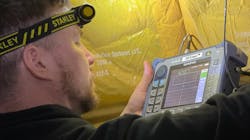Nondestructive testing (NDT) is crucial and varied, with different methods fulfilling different roles in the crusade to detect otherwise obscured damage.
Sean Walty, NDT Director for Jet East Aviation, said there are five major NDT disciplines.
“Here at Jet East, we have multiple technicians certified in all five methods: Eddy Current Testing (ET), Ultrasonic Testing (UT), Liquid Penetrant Testing (FPI), Magnetic Particle Testing (MT), and Radiographic Testing (RT),” he said.
While each method has a specific use, noted Walty, they can be combined to validate potential indications.
“For example, ET is widely used in aircraft inspections, and FPI would be a good choice for validating indications that are open to the surface,” he explained.
ET and FPI inspections are widely used for surface and subsurface indications. UT is a suitable inspection method for assessing subsurface conditions and general material thickness. MT is commonly employed for ferrous materials, such as aircraft nuts and bolts.
“The above inspections are primarily considered portable inspection methods and can be conducted at customers' facilities,” Walty said.
RT requires the most training and licenses, and the associated equipment costs are generally high.
“Most aircraft manufacturers include some form of RT inspections in their NDT manuals. These inspections can be performed remotely, typically at an FBO where they are licensed,” he continued.
Finding Damage
The most basic form of NDT is the visual inspection, said Roger Engelbart, member of the board of directors for the American Society for Nondestructive Testing, and can find a number of discontinuity types in both composite and metallic structures.
Keys to a good visual examination are:
- Adequate lighting
- Magnification
- Accessibility/orientation
- Examiner visual acuity and patience
“The unaided eye is usually the first approach used in visual inspection; this is especially true for in-service damage assessments during which a complete walk-around of the aircraft is the initial procedure. General visual inspection utilizes such aids as magnifiers, mirrors, hand measurement tools and borescopes,” said Engelbart.
“Unless a specific damage location is already known, the process begins with a visual walk around of the aircraft, looking indications of potential damage,” he said.
The first indication is the condition of the paint – chipping, cracking, indentation due to impact, or discoloration due to overheating. Any of these indications prompts a closer visual examination to determine if there is a likelihood of subsurface or internal damage.
Walty said that when they start their inspection, they’re not looking for damage but discontinuities.
“Every inspection is conducted according to the manufacturer's NDT manual, ASTM standard, or in-house NDT manuals. This ensures inspection reliability, repeatability, and assurance that any and all discontinuities are detected and captured,” he said.
The choice of appropriate NDT methods is primarily guided by the NDT manuals provided by manufacturers. When an inspection is not covered in an NDT manual, procedures must be developed by the appropriate Level III Technician. These procedures encompass inspection methods, tooling, standards and acceptability limits.
The number one rule is to follow the procedures. The most common mistakes arise from deviating from written procedures and assuming that the inspection hasn't changed since the last time it was conducted, Walty said.
“When in doubt, it's important to ask questions. Aircraft manufacturers are always available to provide answers. Despite the hundreds of hours required to obtain certification, our certifications serve as licenses to continue learning,” he continued.
Engelbart added that the main NDT best practices are to have the appropriate training and proficiency levels, procedures that have been developed and validated for the applications, and a thorough understanding of the capabilities and limitations of each method.
“Mistakes can occur when an NDT method is utilized for an application for which it is not well suited,” he said.
Companies conducting NDT work on aircraft must have NDT ratings on their Operations Specifications for each certified method. Furthermore, some aircraft manufacturers may impose additional training and certification requirements for authorization to perform specific inspections, Walty noted.
Getting NDT Trained
In aviation, certification is obtained as inspectors through NAS-410 (Qualifications and Certifications in NDT). The requirements for training and certification are established by National Aerospace Standard (NAS) 410. These standards cover various aspects, including visual acuity tests, classroom hours, and experience hours. NAS-410 outlines the different certification levels and their respective roles and duties, said Walty.
“We all start as NDT trainees and progress through each level of certification by completing classroom training and accumulating experience hours. The certification process is rigorous, requiring a substantial number of experience hours and classroom training,” he continued.
Engelbart said the process begins with formal classroom training in the NDT method, followed by on-the-job experience, and examination to a proficiency level after the training and experience requirements have been met. The following is a brief description of the proficiency levels:
- Level I – Performs calibration of equipment, test set ups, operation of equipment – this level cannot make accept/reject decisions on parts.
- Level II – Performs Level I duties, plus interpretation of test results, making of accept/reject decisions, and establishment of procedures – this level cannot approve procedures.
- Level III – Performs Level II duties, plus approval of procedures, interpretation of specifications, supervision of training and certification activities.
“Formal training hours for Level II vary from 32 for magnetic Particle Testing and Penetrant Testing to 80 for Ultrasonic Testing, and as much as 120 for training in both film and non-film (digital) techniques for RT. The required experience ranges from 400 hours for Penetrant Testing to as much as 1000 hours for both Radiography Testing techniques,” Engelbart added. “The process could take 6 – 18 months to qualify for Level II after the formal training has been completed. An individual may be working on multiple certifications simultaneously, but still has to meet the required number of hours.”
There are various pathways to start an NDT career, including universities, the military, and apprentice programs with NDT companies.
“Obtaining certification according to NAS-410 requirements is a lengthy process that requires dedication and determination. Many individuals in the NDT field have prior military experience, as the military provides valuable training and experience hours for certification. Additionally, some universities offer associate degrees in NDT, providing the necessary classroom hours,” said Walty.
About the Author
Walker Jaroch
Editor
Contact: Walker Jaroch
Editor | AMT
+1-920-568-8399
>> To download the AviationPros media kits, visit: Marketing Resource Center
>>Check out our aviation magazines: Ground Support Worldwide | Airport Business | Aircraft Maintenance Technology

